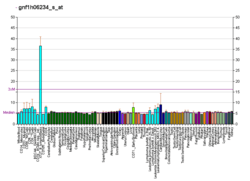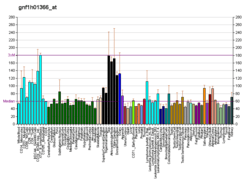CPSF2
Cleavage and polyadenylation specificity factor subunit 2 is a protein that in humans is encoded by the CPSF2 gene.[5][6][7]
References
- 1 2 3 GRCh38: Ensembl release 89: ENSG00000165934 - Ensembl, May 2017
- 1 2 3 GRCm38: Ensembl release 89: ENSMUSG00000041781 - Ensembl, May 2017
- ↑ "Human PubMed Reference:".
- ↑ "Mouse PubMed Reference:".
- ↑ Jenny A, Hauri HP, Keller W (Dec 1994). "Characterization of cleavage and polyadenylation specificity factor and cloning of its 100-kilodalton subunit". Mol Cell Biol. 14 (12): 8183–90. PMC 359357. PMID 7969155.
- ↑ Samiotaki M, Balatsos NA, Courtis N, Tsiapalis CM (Jan 2001). "Assignment of the 100-kDa subunit of cleavage and polyadenylation specificity factor (CPSF2) to human chromosome 14q31.3 by radiation hybrid mapping". Cytogenet Cell Genet. 90 (3–4): 328–9. doi:10.1159/000056798. PMID 11124543.
- ↑ "Entrez Gene: CPSF2 cleavage and polyadenylation specific factor 2, 100kDa".
External links
- Human CPSF2 genome location and CPSF2 gene details page in the UCSC Genome Browser.
Further reading
- Murthy KG, Manley JL (1995). "The 160-kD subunit of human cleavage-polyadenylation specificity factor coordinates pre-mRNA 3'-end formation". Genes Dev. 9 (21): 2672–83. doi:10.1101/gad.9.21.2672. PMID 7590244.
- Thuresson AC, Aström J, Aström A, et al. (1994). "Multiple forms of poly(A) polymerases in human cells". Proc. Natl. Acad. Sci. U.S.A. 91 (3): 979–83. doi:10.1073/pnas.91.3.979. PMC 521437. PMID 8302877.
- Bienroth S, Keller W, Wahle E (1993). "Assembly of a processive messenger RNA polyadenylation complex". EMBO J. 12 (2): 585–94. PMC 413241. PMID 8440247.
- Schul W, Groenhout B, Koberna K, et al. (1996). "The RNA 3' cleavage factors CstF 64 kDa and CPSF 100 kDa are concentrated in nuclear domains closely associated with coiled bodies and newly synthesized RNA". EMBO J. 15 (11): 2883–92. PMC 450226. PMID 8654386.
- McCracken S, Fong N, Yankulov K, et al. (1997). "The C-terminal domain of RNA polymerase II couples mRNA processing to transcription". Nature. 385 (6614): 357–61. doi:10.1038/385357a0. PMID 9002523.
- Takagaki Y, Manley JL (2000). "Complex protein interactions within the human polyadenylation machinery identify a novel component". Mol. Cell. Biol. 20 (5): 1515–25. doi:10.1128/MCB.20.5.1515-1525.2000. PMC 85326. PMID 10669729.
- Nagase T, Kikuno R, Ishikawa KI, et al. (2000). "Prediction of the coding sequences of unidentified human genes. XVI. The complete sequences of 150 new cDNA clones from brain which code for large proteins in vitro". DNA Res. 7 (1): 65–73. doi:10.1093/dnares/7.1.65. PMID 10718198.
- Monsalve M, Wu Z, Adelmant G, et al. (2000). "Direct coupling of transcription and mRNA processing through the thermogenic coactivator PGC-1". Mol. Cell. 6 (2): 307–16. doi:10.1016/S1097-2765(00)00031-9. PMID 10983978.
- de Vries H, Rüegsegger U, Hübner W, et al. (2000). "Human pre-mRNA cleavage factor II(m) contains homologs of yeast proteins and bridges two other cleavage factors". EMBO J. 19 (21): 5895–904. doi:10.1093/emboj/19.21.5895. PMC 305781. PMID 11060040.
- Hodgman R, Tay J, Mendez R, Richter JD (2001). "CPEB phosphorylation and cytoplasmic polyadenylation are catalyzed by the kinase IAK1/Eg2 in maturing mouse oocytes". Development. 128 (14): 2815–22. PMID 11526086.
- Strausberg RL, Feingold EA, Grouse LH, et al. (2003). "Generation and initial analysis of more than 15,000 full-length human and mouse cDNA sequences". Proc. Natl. Acad. Sci. U.S.A. 99 (26): 16899–903. doi:10.1073/pnas.242603899. PMC 139241. PMID 12477932.
- Ota T, Suzuki Y, Nishikawa T, et al. (2004). "Complete sequencing and characterization of 21,243 full-length human cDNAs". Nat. Genet. 36 (1): 40–5. doi:10.1038/ng1285. PMID 14702039.
- Kaufmann I, Martin G, Friedlein A, et al. (2005). "Human Fip1 is a subunit of CPSF that binds to U-rich RNA elements and stimulates poly(A) polymerase". EMBO J. 23 (3): 616–26. doi:10.1038/sj.emboj.7600070. PMC 1271804. PMID 14749727.
- Beausoleil SA, Jedrychowski M, Schwartz D, et al. (2004). "Large-scale characterization of HeLa cell nuclear phosphoproteins". Proc. Natl. Acad. Sci. U.S.A. 101 (33): 12130–5. doi:10.1073/pnas.0404720101. PMC 514446. PMID 15302935.
- Gerhard DS, Wagner L, Feingold EA, et al. (2004). "The status, quality, and expansion of the NIH full-length cDNA project: the Mammalian Gene Collection (MGC)". Genome Res. 14 (10B): 2121–7. doi:10.1101/gr.2596504. PMC 528928. PMID 15489334.
- Kimura K, Wakamatsu A, Suzuki Y, et al. (2006). "Diversification of transcriptional modulation: large-scale identification and characterization of putative alternative promoters of human genes". Genome Res. 16 (1): 55–65. doi:10.1101/gr.4039406. PMC 1356129. PMID 16344560.
- Olsen JV, Blagoev B, Gnad F, et al. (2006). "Global, in vivo, and site-specific phosphorylation dynamics in signaling networks". Cell. 127 (3): 635–48. doi:10.1016/j.cell.2006.09.026. PMID 17081983.
- Ewing RM, Chu P, Elisma F, et al. (2007). "Large-scale mapping of human protein-protein interactions by mass spectrometry". Mol. Syst. Biol. 3 (1): 89. doi:10.1038/msb4100134. PMC 1847948. PMID 17353931.
This article is issued from
Wikipedia.
The text is licensed under Creative Commons - Attribution - Sharealike.
Additional terms may apply for the media files.





